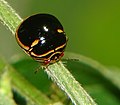Biology
These bugs are phytophagous, polyphagous or oligophagous, mainly associated with the Fabaceae, but can also feed on plants of other families. Some may feed on fungi.
They harbor microorganisms in their digestive tract, specific to each host species, living in symbiosis with it.
They are gregarious and can be found in large groups.
Social behaviors have been observed in Libyaspis : the adults, well protected by their pronotum and their scutellum covering the entire abdomen, group together at the base of the branches in which the larvae develop, thus preventing the access of predatory ladybug larvae.
Little is known about their biology.
Distribution
This family is of Old World origin only, found primarily in tropical and subtropical areas. Some species of Coptosoma are found in temperate areas. A few species have, however, been introduced to the American continent and some Pacific islands (such as Hawaii).
Only one genus occurs in Europe, Coptosoma, with only one widely distributed species, Coptosoma scutellatum and three Mediterranean species: C. sandahli in Sicily, C. costale in Cyprus, and C. mucronatum in the Balkans.
This page is based on this
Wikipedia article Text is available under the
CC BY-SA 4.0 license; additional terms may apply.
Images, videos and audio are available under their respective licenses.










